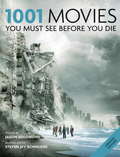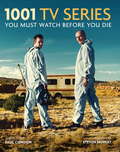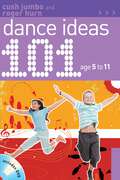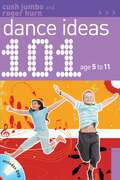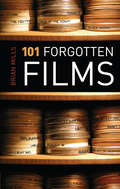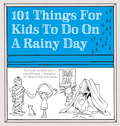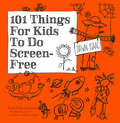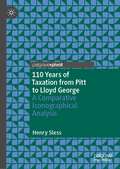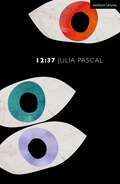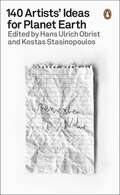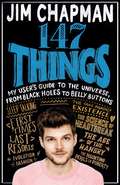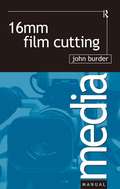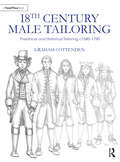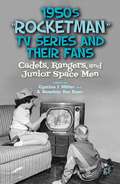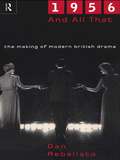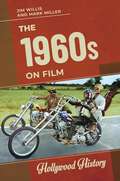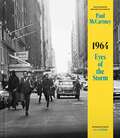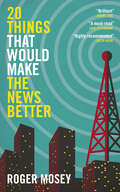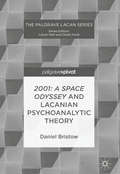- Table View
- List View
1001 Movies You Must See Before You Die: You Must See Before You Die 2011 (1001)
by Steven Jay Schneider"I have, by the way, seen 943 of the 1001 movies, and am carefully rationing the remaining titles to prolong my life." - Roger Ebert"1001 ways to give cinema new scope." - The HeraldExpert critics in each genre of film, from romance to horror and sci-fi, have once again painstakingly revised this list of essential must see-movies, cut and added films to bring the must-watch list bang up to date for 2013, from great classics like The Birth of a Nation and Gone With the Wind to recent Oscar winners like Life of Pi, Amour, Argo and the blockbusters that is Skyfall. Each entry tells you exactly why these films deserve inclusion in this definitive illustrated list, engaging readers in each film's concept development and production, including curious trivia facts about the movies, as well as the most famous pieces of memorabilia associated with them.Illustrated with hundreds of stunning film stills, portraits and poster art 1001 Movies You Must See Before You Dieoffers an incredible visual insight into the world of modern cinema. It puts together the most significant movies from all genres, from animation to Western, through action, comedy, documentary, musical, noir, romance, thriller, short and sci-fi. Movies from over 30 different countries have been included, offering a truly wide multi-cultural perspective, and the time span includes more than a century of extraordinary cinematography. Packed with vital statistics, and a few facts that might surprise you, this is a collector's must for the bookshelf as well as an entertaining read for all those who love the world of film. Whether your passion lies with The Blue Angel or Blue Velvet, from the films you shouldn't have missed the first time around, to the films you can see again and again, 1001 Movies You Must See Before You Die is the definitive guide for all movie lovers.Contents includes... Introduction19001910192019301940 195019601970 198019902000
1001 TV Series: You Must Watch Before You Die (1001)
by Paul CondonThis is the ultimate book for the Netflix and boxset generation, featuring all the greatest drama series ever broadcast as well as the weirdest game shows, controversial reality TV experiments and breathtaking nature documentaries.It is a must for anyone who wants to know why India's Ramayan is legendary, why Roots was groundbreaking, or what the ending of Lost was all about. Written by an international team of critics, authors, academics, producers and journalists, this book reviews TV series from more than 20 countries, highlights classic episodes to watch and also provides cast summaries and production details.
101 Dance Ideas age 5-11 (101 Drills Ser.)
by Roger Hurn Ms Cush JumboA book jam-packed full of fun dances, dance steps andchoreographed routines for primary children and teachers. Written inthe 101 series style - a series trusted by primary school teachers. Includes: Warm up and cool down, Easy dances (e.g. Kenyan hop,Twist), Medium dances (e.g. Hilly Billy, Mambo), Harder dances (e.g.Salsa, Cha cha).An introduction explains the importance of getting childrendancing to improve their fitness and develop their listening andthinking skills.
101 Dance Ideas age 5-11 (101 Drills)
by Cush Jumbo Roger HurnA book jam-packed full of fun dances, dance steps andchoreographed routines for primary children and teachers. Written inthe 101 series style - a series trusted by primary school teachers. Includes: Warm up and cool down, Easy dances (e.g. Kenyan hop,Twist), Medium dances (e.g. Hilly Billy, Mambo), Harder dances (e.g.Salsa, Cha cha).An introduction explains the importance of getting childrendancing to improve their fitness and develop their listening andthinking skills. Each dance comes with a step-by-step set ofinstructions, backed up with a DVD showing Cush Jumbo going through the steps.
101 Forgotten Films
by Brian MillsSomewhere in the labyrinth of our memories are films that we have seen and cannot forget but frustratingly may never see again because they have mysteriously vanished from the public domain. They may be hidden away in a film studio's vault, buried beneath the floorboards of a filmmaker's home, imprisoned by some ancient legality, refused release at a director's whim or simply not optioned by a distributor.This book brings back to life 101 films that are entombed in a cinema cemetery and in so doing unearths a film noir masterpiece, a French classic, a Mastroianni feature comparable to Cinema Paradiso, a pioneering Independent film of the fifties, a Joan Crawford headliner, an amazing Nicholas Ray experimental feature, Italian comedies by Nichetti and lost gems by Widerberg, Hitchcock, Lang, Ford, Lubitsch, Litvak, Dmytryk, Kazan, Cacoyannis, Boetticher, Zinnemann, Ray, Huston and many more luminaries of the silver screen.No film is guaranteed a general release whether screened at Sundance or Cannes and though critics may acclaim them, audiences applaud them, too many disappear into oblivion. This book pays homage to those lost films that deserve to be exhibited beyond the screen of our mind.'An astonishing list of neglected classics, this is a genuine revelation' - Film Review'Kamera Books adds to its terrific collection with this addictive compendium of obscure films from the '20s to today' - Empire Magazine'I've seen just six of the films extolled in this short, snappy survey, one of which, The Victors, the only movie ever directed by Carl Foreman, finally popped up at some unearthly hour on TV recently. What a treat it proved to be' - Quentin Falk, Academy Magazine
101 Things for Kids to do on a Rainy Day
by Dawn IsaacFrom the author of 101 Things for Kids to do Outside, which has fast become a go-to book for children and parents alike, comes this excellent new volume full of creative (and occasionally crazy) ideas for things to do when the weather is bad and you're stuck inside - without having to go any where near a TV or computer screen! Why not grow a windowsill herb garden, make your own jigsaw, or learn to play the glasses? Get crafty with decoupage and salt dough, or play detective by dusting for fingerprints. Exciting makes include terrariums and kaleidoscopes, whilst wacky games cover everything from Balloon Stomp to Sticky Note Scramble. All 101 ideas are designed to be achievable with little or no parental help, and only use materials that you already have around the house. With a wealth of creative and fun suggestions to keep you amused, you might not even notice that the rain has stopped.
101 Things for Kids to do Screen-Free (101 things)
by Dawn Isaac'Packed with original ideas.' - the Telegraph on 101 Things for Kids To Do on a Rainy Day'A quarter of the price of a theme-park ticket and delivers significantly better value for money.' - the Independent on 101 Things for Kids To Do Outside From bestselling kids' activity author Dawn Isaac comes this exciting new volume full of creative, fun and occasionally silly ideas for games and activities. From creating a mini golf course to mastering hands-free eating, from squirt gun painting to microwave mug cakes, every single activity is fun, easy and 100 per cent screen free. With exciting makes including no-sew sock creatures and stress balls, and wacky games such as outdoor noughts and crosses and thumb wrestling tournaments, Dawn's engaging and entertaining ideas are sure to provide hours of fun.So put away your tablets and mobile phones, switch off the TV and leave the computer alone - it's time to get screen free.
110 Years of Taxation from Pitt to Lloyd George: A Comparative Iconographical Analysis
by Henry SlessThis book offers a multi-disciplinary visual analysis of British taxation history during the long nineteenth century. Focusing specifically on cartoons from the period, the book utilises the author’s innovative PEARL methodology to analyse the impact of Publishers’ attitudes, Editorial techniques, Artistic methods, Readers’ responses, and Legal context on historical images published in this period.The book outlines a financial and visual context for the long nineteenth century, discussing the importance of political images during a period when the relationship between the state and the taxpayer was fundamentally shifting. The state of public finance in Britain as a whole, including the growth of institutional finance, the economic impact of wars, and attempts to reduce the national debt, are considered alongside an exploration of the recurring iconographical styles of the period. The book situates the visual history of taxation within a wider context of politicised images responding to fiscal events, and uses the PEARL analysis technique to pinpoint nuanced and evolving public attitudes towards tax structures in Britain, as well as comparative developments in the US such as the impact of the Civil War and income tax debates. The book will be of interest to financial historians and academic cultural historians, as well as all those interested in visual culture and political imagery.
12:37 (Modern Plays)
by Julia PascalDoes Tommy know you're Jewish?Tommy knows I'm Irish.At 12:37pm on 22 July 1946, the King David Hotel in Jerusalem was bombed. 91 people were killed, 46 wounded. The bombing was carried out by right-wing Zionists, targeting the headquarters of the British in Palestine.Two Irish Jewish brothers, Paul and Cecil Green, journey from their Dublin birthplace to battle antisemitism on the streets of East London. Their Irish nationalism propels them towards Jewish nationalism as they struggle against British Imperialism to form a Jewish nation state. As violence between British soldiers and Jewish terrorists erupts, Paul and Cecil become involved in an act of terrorism that changes both their lives.12:37 raises complex and controversial questions around Jewish violence, homeland and national identity in a stunning new play that is both a hard-hitting historical epic and an intimate family drama.This edition was published to coincide with the world premiere at the Finborough Theatre, London, in November 2022.
12:37 (Modern Plays)
by Julia PascalDoes Tommy know you're Jewish?Tommy knows I'm Irish.At 12:37pm on 22 July 1946, the King David Hotel in Jerusalem was bombed. 91 people were killed, 46 wounded. The bombing was carried out by right-wing Zionists, targeting the headquarters of the British in Palestine.Two Irish Jewish brothers, Paul and Cecil Green, journey from their Dublin birthplace to battle antisemitism on the streets of East London. Their Irish nationalism propels them towards Jewish nationalism as they struggle against British Imperialism to form a Jewish nation state. As violence between British soldiers and Jewish terrorists erupts, Paul and Cecil become involved in an act of terrorism that changes both their lives.12:37 raises complex and controversial questions around Jewish violence, homeland and national identity in a stunning new play that is both a hard-hitting historical epic and an intimate family drama.This edition was published to coincide with the world premiere at the Finborough Theatre, London, in November 2022.
140 Artists’ Ideas for Planet Earth
by Hans Ulrich Obrist Kostas StasinopoulosThrough 140 drawings, thought experiments, recipes, activist instructions, gardening ideas, insurgences and personal revolutions, artists who spend their lives thinking outside the box guide you to a new worldview; where you and the planet are one.Everything here is new. We invite you to rip out pages, to hang them up at home, to draw and scribble, to cook, to meditate, to take the book to your nearest green space.Featuring Olafur Eliasson, Etel Adnan, Alexis Pauline Gumbs, Jane Fonda & Swoon, Judy Chicago, Black Quantum Futurism Collective, Vivienne Westwood, Cauleen Smith, Marina Abramovic, Karrabing Film Collective, and many more.
147 Things: A hilariously brilliant guide to this thing called life
by Jim Chapman'It's Sapiens for teenagers.' The TimesLIFE IS WEIRD.Nothing gives you a sense of perspective like finding out just how weird.I'm an extremely curious chap and with this book I wanted to share the content of my noggin, because I think these are the 147 things that have helped me through this thing we call life. Sometimes because it shows how lucky we are to be here at all, but often because I’m a moron and learned whatever lesson it taught me the hard way, and I’d like to save you the pain of making the same mistakes (I refer here to the waxing of my pubic hair).Ever wondered if first times are over-rated (hint: they are), whether you’ll ever find the one (hint: there are 7 billion of us) or pondered the sheer unlikelihood of the you who is you being in the world right now? If so, then YouTube superstar and fact-obsessed, over-sharer Jim Chapman is here to explain it all – whether it’s why your heart actually aches after a break-up, what’s happening when you get hangry, or why people are just so plain RUDE online.Along the way, we’ll find out how much fun he has when Tanya’s sleep-talking and why he looked like a gangly T-rex with wonky teeth when he was a teenager. As with his videos, no subject is off-limits, as Jim lifts the lid on his life and his relationships, sharing embarrassing stories and things he’s learnt along the way (trust us, the thing about kangaroos will really freak you out).
16mm Film Cutting (Media Manuals Ser.)
by John BurderThe film editor can make or break a film. What ends up on the cutting room floor, and why? 16mm Film Cutting is a step-by-step guide to film cutting which shows you how to achieve professional results.The practical side of the editor's job is clearly described and illustrated; breaking down rushes and making a simple join, identifying shots, first assembly, avoiding errors, preparing special effects, instructing the labs, compiling sound tracks and all the other stages in producing the final film. 16mm Film Cutting is an indispensable aid to editors and assistants working in all areas of 16mm film production.
16mm Film Cutting
by John BurderThe film editor can make or break a film. What ends up on the cutting room floor, and why? 16mm Film Cutting is a step-by-step guide to film cutting which shows you how to achieve professional results.The practical side of the editor's job is clearly described and illustrated; breaking down rushes and making a simple join, identifying shots, first assembly, avoiding errors, preparing special effects, instructing the labs, compiling sound tracks and all the other stages in producing the final film. 16mm Film Cutting is an indispensable aid to editors and assistants working in all areas of 16mm film production.
18th Century Male Tailoring: Theatrical and Historical Tailoring c1680 – 1790
by Graham Cottenden18th Century Male Tailoring: Theatrical and Historical Tailoring c1680 – 1790 introduces the reader to English eighteenth-century tailoring and covers the drafting of patterns, cutting out in cloth and construction techniques in sequence for the tailoring of waistcoats, breeches and coats. From choosing the right cloth to preparing for the fitting process, this how-to guide will help readers create beautiful, historically accurate eighteenth-century male garments for events and performances. The book contains the following: step-by-step instructions complete with illustrations for students and costumiers who are new to the making of male tailored garments from the eighteenth century; drafting blocks and construction techniques for the different styles through the eighteenth century and patterns, photographs, detailed measurements and articles taken from a variety of male coats, waistcoats and trousers from c1680 – c1790 from museums and collections. 18th Century Male Tailoring is written for costume design and construction students, fashion students and practitioners who have a reasonable working knowledge of sewing and general costume making, but not necessarily of tailoring, drafting patterns, cutting skills and the making of male garments.
18th Century Male Tailoring: Theatrical and Historical Tailoring c1680 – 1790
by Graham Cottenden18th Century Male Tailoring: Theatrical and Historical Tailoring c1680 – 1790 introduces the reader to English eighteenth-century tailoring and covers the drafting of patterns, cutting out in cloth and construction techniques in sequence for the tailoring of waistcoats, breeches and coats. From choosing the right cloth to preparing for the fitting process, this how-to guide will help readers create beautiful, historically accurate eighteenth-century male garments for events and performances. The book contains the following: step-by-step instructions complete with illustrations for students and costumiers who are new to the making of male tailored garments from the eighteenth century; drafting blocks and construction techniques for the different styles through the eighteenth century and patterns, photographs, detailed measurements and articles taken from a variety of male coats, waistcoats and trousers from c1680 – c1790 from museums and collections. 18th Century Male Tailoring is written for costume design and construction students, fashion students and practitioners who have a reasonable working knowledge of sewing and general costume making, but not necessarily of tailoring, drafting patterns, cutting skills and the making of male garments.
1950s “Rocketman” TV Series and Their Fans: Cadets, Rangers, and Junior Space Men
by Cynthia J. MillerThe fourteen essays featured here focus on series such as Space Patrol, Tom Corbett, and Captain Z-Ro, exploring their roles in the day-to-day lives of their fans through topics such as mentoring, promotion of the real-world space program, merchandising, gender issues, and ranger clubs - all the while promoting the fledgling medium of television.
1956 and All That: The Making of Modern British Drama
by Dan RebellatoIt is said that British Drama was shockingly lifted out of the doldrums by the 'revolutionary' appearance of John Osborne's Look Back in Anger at the Royal Court in May 1956. But had the theatre been as ephemeral and effeminate as the Angry Young Men claimed? Was the era of Terence Rattigan and 'Binkie' Beaumont as repressed and closeted as it seems? In this bold and fascinating challenge to the received wisdom of the last forty years of theatrical history, Dan Rebellato uncovers a different story altogether. It is one where Britain's declining Empire and increasing panic over the 'problem' of homosexuality played a crucial role in the construction of an enduring myth of the theatre. By going back to primary sources and rigorously questioning all assumptions, Rebellato has rewritten the history of the Making of Modern British Drama.
1956 and All That: The Making of Modern British Drama
by Dan RebellatoIt is said that British Drama was shockingly lifted out of the doldrums by the 'revolutionary' appearance of John Osborne's Look Back in Anger at the Royal Court in May 1956. But had the theatre been as ephemeral and effeminate as the Angry Young Men claimed? Was the era of Terence Rattigan and 'Binkie' Beaumont as repressed and closeted as it seems? In this bold and fascinating challenge to the received wisdom of the last forty years of theatrical history, Dan Rebellato uncovers a different story altogether. It is one where Britain's declining Empire and increasing panic over the 'problem' of homosexuality played a crucial role in the construction of an enduring myth of the theatre. By going back to primary sources and rigorously questioning all assumptions, Rebellato has rewritten the history of the Making of Modern British Drama.
The 1960s on Film (Hollywood History)
by Jim Willis Mark MillerThe 1960s on Film tells the narrative of the 1960s through the lens of the movie camera, analyzing 10 films that focus on the people, events, and issues of the decade.Films create both an impression of and — at times for younger audiences — a primary definition of events, people, and issues of an era. The 1960s on Film examines the 1960s as the decade was presented in ten films that focused on that decade. Discussion will focus on both what the films have to say about the era and how close they come to accurately depicting it.For example, films such as Mississippi Burning and Selma tell the story of racial conflict and hope for reconciliation in the 1960s. Other films such as The Right Stuff and Hidden Figures show the deep fascination America had at that time with the burgeoning space program and NASA, while Easy Rider analyzes the role of rock music and drugs among young people of the decade. The Deer Hunter studies the controversies surrounding the war in Vietnam. The Graduate, Mad Men, JFK, and Thirteen Days also receive significant treatment in this exciting volume.
The 1960s on Film (Hollywood History)
by Jim Willis Mark MillerThe 1960s on Film tells the narrative of the 1960s through the lens of the movie camera, analyzing 10 films that focus on the people, events, and issues of the decade.Films create both an impression of and — at times for younger audiences — a primary definition of events, people, and issues of an era. The 1960s on Film examines the 1960s as the decade was presented in ten films that focused on that decade. Discussion will focus on both what the films have to say about the era and how close they come to accurately depicting it.For example, films such as Mississippi Burning and Selma tell the story of racial conflict and hope for reconciliation in the 1960s. Other films such as The Right Stuff and Hidden Figures show the deep fascination America had at that time with the burgeoning space program and NASA, while Easy Rider analyzes the role of rock music and drugs among young people of the decade. The Deer Hunter studies the controversies surrounding the war in Vietnam. The Graduate, Mad Men, JFK, and Thirteen Days also receive significant treatment in this exciting volume.
1964: Eyes Of The Storm
by Paul McCartneyPhotographs and Reflections by Paul McCartney'Millions of eyes were suddenly upon us, creating a picture I will never forget for the rest of my life.'In 2020, an extraordinary trove of nearly a thousand photographs taken by Paul McCartney on a 35mm camera was re-discovered in his archive. They intimately record the months towards the end of 1963 and beginning of 1964 when Beatlemania erupted in the UK and, after the band's first visit to the USA, they became the most famous people on the planet. The photographs are McCartney's personal record of this explosive time, when he was, as he puts it, in the 'Eyes of the Storm'.1964: Eyes of the Storm presents 275 of McCartney's photographs from the six cities of these intense, legendary months - Liverpool, London, Paris, New York, Washington, D.C. and Miami - and many never-before-seen portraits of John, George and Ringo. In his Foreword and Introductions to these city portfolios, McCartney remembers 'what else can you call it - pandemonium' and conveys his impressions of Britain and America in 1964 - the moment when the culture changed and the Sixties really began.1964: Eyes of the Storm includes:- Six city portfolios - Liverpool, London, Paris, New York, Washington, D.C. and Miami - and a Coda on the later months of 1964 - featuring 275 of Paul McCartney's photographs and his candid reflections on them- A Foreword by Paul McCartney- Beatleland, an Introduction by Harvard historian and New Yorker essayist Jill Lepore- A Preface by Nicholas Cullinan, Director of the National Portrait Gallery, London, and Another Lens, an essay by Senior Curator Rosie Broadley
20 Things That Would Make the News Better
by Roger Mosey“A brilliant A-to-Z for the modern newsroom.” – Jeremy Vine “A must-read.” – Julie Etchingham “Highly recommended reading.” – Justin Webb *** We are at a defining point in the history of news. Following a surge of fake news, clickbait and conspiracy theories, the 2020s have ushered in a welter of existential threats for public service broadcasting. So, where do we go from here? Former Today editor and head of BBC television news Roger Mosey thinks public service broadcasters must buck the trends and in this incisive book he offers twenty core ways in which the news can save itself by getting smarter, sharper, more diverse, more nuanced and less exposed to pummelling by politicians. Mosey sees two possible futures: one in which the incitements of populist demagogues and the passions of social media are ever dominant – or one where we fight hard to retain media that has an interest in the public good and preserves truth, fairness and evidence-based judgements. From one of British broadcasting’s most experienced voices comes the definitive exploration of Britain’s news output and what must change if we are to avoid a future of uninspiring news, uninformed decision-making and accountability-dodging politicians.
2001: A Space Odyssey and Lacanian Psychoanalytic Theory
by Daniel BristowIn 1968, Stanley Kubrick completed and released his magnum opus motion picture 2001: A Space Odyssey; a time that was also tremendously important in the formation of the psychoanalytic theory of Jacques Lacan. Bringing these figures together, Bristow offers a study that goes beyond, as the film did. He extends Lacan’s late topological insights, delves into conceptualisations of desire, in G. W. F. Hegel, Alexandre Kojève, and Lacan himself, and deals with the major themes of cuts (filmic and psychoanalytic); space; silence; surreality; and ‘das Ding’, in relation to the movie’s enigmatic monolith. This book is a tour de force of psychoanalytic theory and space odyssey that will appeal to academics and practitioners of psychoanalysis and film studies, as well as to any fan of Kubrick’s work.
2001: A Space Odyssey and Lacanian Psychoanalytic Theory
by Daniel BristowIn 1968, Stanley Kubrick completed and released his magnum opus motion picture 2001: A Space Odyssey; a time that was also tremendously important in the formation of the psychoanalytic theory of Jacques Lacan. Bringing these figures together, Bristow offers a study that goes beyond, as the film did. He extends Lacan’s late topological insights, delves into conceptualisations of desire, in G. W. F. Hegel, Alexandre Kojève, and Lacan himself, and deals with the major themes of cuts (filmic and psychoanalytic); space; silence; surreality; and ‘das Ding’, in relation to the movie’s enigmatic monolith. This book is a tour de force of psychoanalytic theory and space odyssey that will appeal to academics and practitioners of psychoanalysis and film studies, as well as to any fan of Kubrick’s work.
